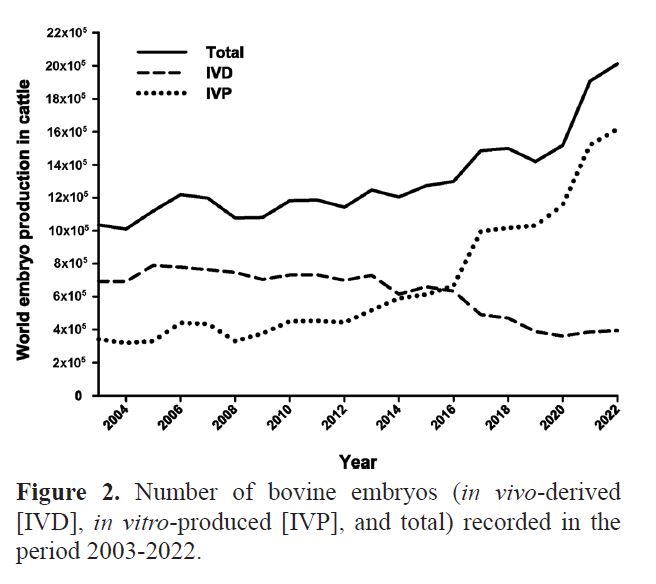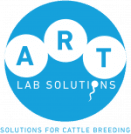In Vitro Fertilisation (IVF) is a reproductive technology utilised to accelerate genetic gain within a herd. Market analysis shows that the IVF technology is rapidly being adopted, with predominant markets in South America and North America. Data from International Embryo Transfer Society (IETS) 2023 report has demonstrated significant growth of the IVF or In Vitro Production (IVP) technology over the past decade. The Figure below shows that IVP is now the preferred method for producing bovine embryos compared with in vivo derived (IVD) technologies.

(Figure derived from the International Embryo Technology Society 2023 Report)
During a natural oestrous cycle, only one oocyte will ovulate every 3 weeks or so, and with natural mating the cow will hopefully produce one calf every year. Utilising embryo technologies, such as IVF in your breeding programs can allow selected valuable cows to produce several offspring every year that will be carried to term by recipient cows who themselves have lower genetic merit. The number of oocytes available from each donor cow varies depending on many factors including breed and age and can range from 1 to over 100 eggs per donor. On average you can expect 10-15 eggs from a bos taurus cow, and 20-30 eggs for a bos indicus cow.
The In Vitro Embryo Production (IVEP) Process
IVEP is a multistep process that includes Ovum Pick Up (OPU), In Vitro Maturation (IVM), In Vitro Fertilisation (IVF) and In Vitro Culture (IVC). Immature oocytes (eggs) from a female of high genetic merit are extracted using an ultrasound-guide probe attached to a vacuum pump. The oocytes are then washed and transported to a laboratory to undergo IVM in a specialised media containing hormones, energy substrates and amino acids. Once matured, the oocytes are placed in a dish and combined with the desired sperm for the fertilisation process.
Following Fertilisation, embryos are cultured to allow the zygotes to cleave/divide until they develop into a blastocyst embryo that is ready to be transferred into oestrous synchronised recipients or cryopreserved for later use. This technology enables the fastest rate of genetic gain to be realised in a herd compared to the other reproductive technologies such as Artificial Insemination (AI) and Multiple Ovulation and Embryo Transfer (MOET).
While AI allows the exploitation of male genetics, embryo technologies can be used to exploit both the male and female genetics allowing for faster gains to be reached. MOET requires a labour-intensive protocol of hormone injections to be applied to donor cows, followed by AI and embryo flushing about a week later. This protocol produces an average of 5 embryos per donor and can be repeated in 6–8-week intervals.
Benefits of the IVF Technology
There are many benefits to IVF such as:
– IVF maximises the genetic potential of elite donor females in the herd.
– Collection of oocytes by OPU can be achieved with no hormone treatment of the donor cows, and is a much simpler and less intensive treatment program compared to MOET.
– OPU allows for the collection of several oocytes every two-weeks that would otherwise be destined for atresia (programmed cell death). This greatly increases the number of potential calves a valuable cow can produce every year (average of 5 embryos per OPU).
– Oocytes can be collected from young heifers and pregnant cows (until approximately 4 months of gestation).
– Ability to fertilise the oocytes from more than one donor using a single straw of frozen semen.
Disadvantages of the IVF Technology
– Requires initial capital to set up laboratory and equipment for the IVEP process.
– Requires technical skills to handle oocytes, sperm and embryos in vitro.
– Slightly lower pregnancy rates when compared to MOET.
On average, fertilisation through the IVF technology is expected to give a fertilisation rate of 80% or slightly lower for sexed semen. Embryo development rates from fertilisation rate are around 40% on average (accordingly to industry standards). Expected pregnancy outcomes are around 45% of total transferred embryos.
Overall, results will vary depending on many extraneous variables such as animal breed and age, seasonality, health status and diet of donor and recipient cows. It is recommended to discuss your program with your provider two months before your scheduled OPU to maximise your success.
For more information on the processes of IVF, contact our team at admin@artlabsolutions.com .
